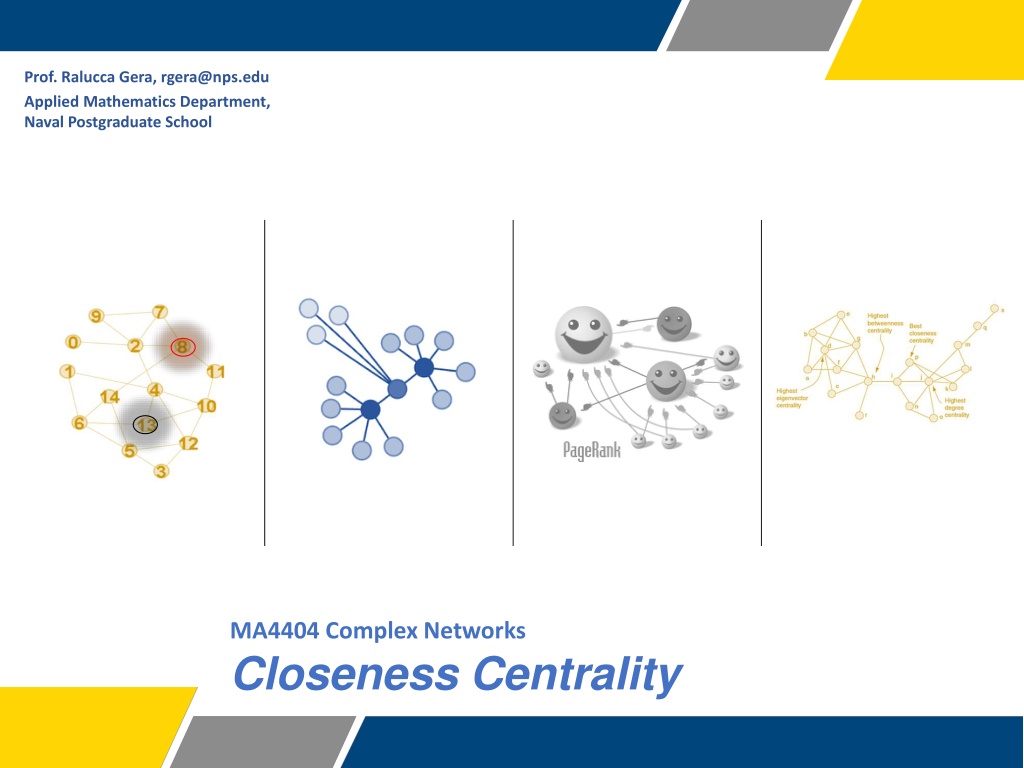
Understanding Centralities in Network Analysis
Explore the concepts of closeness centrality, degree centrality, and more in network analysis. Learn how to compute and interpret centrality values, as well as the importance of different centrality measures in social networks and beyond.
Download Presentation

Please find below an Image/Link to download the presentation.
The content on the website is provided AS IS for your information and personal use only. It may not be sold, licensed, or shared on other websites without obtaining consent from the author. If you encounter any issues during the download, it is possible that the publisher has removed the file from their server.
You are allowed to download the files provided on this website for personal or commercial use, subject to the condition that they are used lawfully. All files are the property of their respective owners.
The content on the website is provided AS IS for your information and personal use only. It may not be sold, licensed, or shared on other websites without obtaining consent from the author.
E N D
Presentation Transcript
Prof. Ralucca Gera, rgera@nps.edu Applied Mathematics Department, Excellence Through Knowledge Naval Postgraduate School MA4404 Complex Networks Closeness Centrality
Understand the new categories of centralities that includes closeness centrality. Compute Closeness Centrality per node. Interpret the meaning of the values of Closeness Centrality. Learning Outcomes
Recallback to Degree Centrality Quality: what makes a node important (central) Mathematical Description Appropriate Usage Identification Lots of one-hop connections from ? The number of vertices that ? influences directly Local influence matters Small diameter Degree centrality (or simply the deg(?)) Lots of one-hop connections from ? relative to the size of the graph The proportion of the vertices that ? influences directly Local influence matters Small diameter Normalized degree centrality deg(?) |V(G)| In the middle of the graph HOW?
How to measure it? Quality: what makes a node important (central) Mathematical Description Appropriate Usage Identification Lots of one-hop connections from ? The number of vertices that ? influences directly Local influence matters Small diameter Degree centrality (or simply the deg(?)) Lots of one-hop connections from ? relative to the size of the graph The proportion of the vertices that ? influences directly Local influence matters Small diameter Normalized degree centrality deg(?) |V(G)| ? In the middle of the graph - closeness centrality Close to everyone at the same time The efficiency of a vertex of reaching everyone quickly (spreading news or a virus for example) ??= 1 ?(?,?) ?=1
5 MA4404: Centralities categories Adjacencies Distances Degree Closeness Eigenvector Betweenness Katz HITS PageRank Discovering Sets of Key Players in Social Networks | SpringerLink
Intuition Closeness Centrality
Why?! What if it s not so important to have many direct friends? But one still wants to be in the middle of the network by being close to many friends. What metric could identify these central nodes? Graph theory: Cen(G) = {v : e(v) is the smallest of all vertices in G} Complex networks: Closeness centrality centrality-measures.png (942 564) (compjournalism.com) 7
Closeness centrality: definition Closeness centrality for node ? is the inverse sum of distance between a vertex i and all vertices in the graph (consider vertices in the same component only): ? ??= 1 ? ?,? . ?=1 (it depends on inverse distance to other vertices) Closeness centrality can be viewed as the efficiency of a vertex in spreading information to all other vertices at the same time. Drawback: only computed per component 8
Examples Examples
Closeness Centrality ? ??= 1 ?(?,?) ?=1 1 ??= ? ?? + ? ?? + ? ?? + ? ?? + ? ?? + ? ?? 1 ??= 1 + 1 + 1 + 2 + 1 + 2 ??=1 8= 0.125
In class exercise: closeness centrality In class exercise: What is the centrality of a vertex in ?4? What is the centrality of a vertex in ?14? What is the centrality of a vertex in ??? Should they be the same regardless of the n? Sometimes, we care for a relative centrality, so it should be the same for all n values, since it identifies central nodes in a certain structure. How would you fix the problem so that it scales with n? ????????????= ? 1 ? ?,? ? ?=1 where n is number of vertices in the graph. In class exercise: What is the normalized closeness centrality of a vertex in ??? 11
Well Defined?! ? ??= 1 ?(?,?) ?=1
Closeness centrality In a typical network the closeness centrality might span a factor of five or less It is difficult to distinguish between central and less central vertices a small change in network might considerably affect the centrality order ? It is well defined?! Consider it in a disconnected network: ??= 1 ?(?,?) ?=1 Alternative computations exist but they have their own problems: Such as the harmonic mean: ? ?= 1 1 ? 1 ? ? ?,? 1 ? ?,? 0 if i and j are in Which works for disconnected graphs since different components. But still small range of values for most networks. Both closeness centrality and harmonic closeness centrality are hardly ever used 13
Generalization How would you generalize this centrality? This is a good time to share your thoughts Closeness centrality of a set rather than a vertex? [PDF] Clustering memes in social media | Semantic Scholar 14
Analysis Python (NetworkX): https://networkx.org/documentation/stable/_modules/networ kx/algorithms/centrality/closeness.html Gephi https://www.youtube.com/watch?v=jb9gG37nHvs R (From Duke University): https://www.youtube.com/watch?v=0aqvVbTyEmcf
